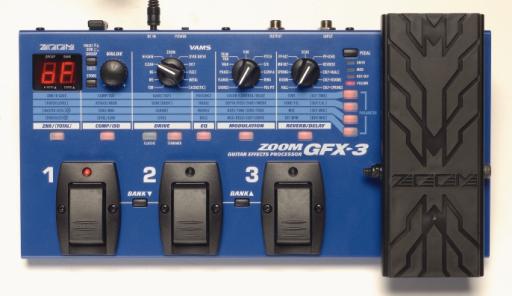MusicRadar Verdict
The street price of the GFX-3 unit is going to attract some serious interest.
Pros
- +
The sturdy construction and quality of the available tones.
Cons
- -
You may need to keep hold of your old Crybaby wah…
MusicRadar's got your back
Zoom has long been at the forefront of the production of affordable yet tonally valid multi-FX and recording units but, no matter how impressive models such as the 505II and 606 undoubtedly are, we'd question whether any player would want to use one live.
The flagship GFX-8 console aside, Zoom's guitar-related products are mostly small and, not to put too fine a point on it, rather plastic in construction.
Which, considering the sheer quality of a majority of the on-board tones of these units, is rather a shame: they'd arguably last half a set beneath the big old boots of many of today's contemporary players.
Enter the GFX-3, a new gladiator into the packed multi-FX arena. It is slim and compact, hewn from the sturdiest steel, and fully loaded with many of the features that have made Zoom so popular over the last decade or so.
Overview
As with similarly priced DigiTech units, the operating system revolves around a process that requires you to match the operation of one of the four parameter keys (sited just to the left of the pedal) with one of a quartet of horizontal light blue sections that represent specific parameters of certain effects and settings.
As always, the description of such a process in words is far more complex than the experience itself: take it from us, it's a doddle.
The unit is split right down the middle, with 60 User and 60 Preset patches, and the idea is that you modify one of the latter to suit and subsequently store in a patch from the former.
If you prefer starting from scratch, you should first turn each module off by pressing each of the module keys (the ones beneath each vertical section) until the LED display reads 'oF': your blank canvas awaits. Assuming you have a basic tone in mind, you should begin with the drive selector.
There are 10 basic distortion and amp sims (as well as a further pair of acoustic selections), the quantity of which is doubled by opting for either the Classic or Standard setting for each.
There are accurate descriptions of each within the manual and, by marrying your choice with one of seven cabinet sims, you're on your way.
To add a touch of chorus, for example, press the Modulation module key, rotate the relevant selector knob to 'Chorus', alter the settings via the four parameter keys and the Value dial, press the Store key once and select a patch with one of the three footswitches.
Store once more and you're faced with a short lightshow from the sum of the unit's keys; the job is complete. Let us reiterate that the process is simplicity itself, and it's very difficult to get lost as you can press the Exit key at any time.
There is an overall master volume for the unit (secreted within the ZNR/Total module) as well as a level for each patch, and the method of setting the on-board expression pedal to do exactly what you want is by far the easiest of any FX unit we've looked at recently - high praise indeed.
Sounds
The GFX-3 comes out of the box complete with an AC adaptor, which should be a popular move, even though Zoom tells us that the alternative method of supplying power (using four AA batteries) will give 11 hours of continuous operation.
You can flick between the banks either with the small up and down keys or - and this will come into its own when you are using the unit live - by using combinations of the three footswitches - 1 and 2 together for bank up, 2 and 3 for bank down.
Zoom's studio-quality digital effects have long been lauded by the most pernickety of players - just ask Brian May - and dialling in a lush blend of chorus, delay, hall reverb and a hint of compression allows you to simply drift away on lapping Gilmouresque waves.
Units such as this stand or fall on the quality of their overdrives and, although the associated high-end efficiency suits ultra-heavy scooped tones, getting an SRV urgency or Santana neck tone has often required a compromise.
Not with the GFX-3, as both of these examples use the Classic FDR model for the first challenge and the Standard BG for Carlos, and are ready to go in minutes.
Down sides? Well, the wah isn't as satisfying as we'd have hoped, and it seems to have a rather limited use as a way of adding extra body to an already driving amp, but for this price, that's not too much to worry about. Accept these restrictions and you'll be as impressed as we are.
It is a revelation, with its shiny new tank-proof chassis protecting a digital heart that can produce some excellent tones any player would relish.
Simon Bradley is a guitar and especially rock guitar expert who worked for Guitarist magazine and has in the past contributed to world-leading music and guitar titles like MusicRadar (obviously), Guitarist, Guitar World and Louder. What he doesn't know about Brian May's playing and, especially, the Red Special, isn't worth knowing.
“The verse tricks you into thinking that it’s in a certain key and has this ‘simplistic’ musical language, but then it flips”: Charli XCX’s Brat collaborator Jon Shave on how they created Sympathy Is A Knife
“It shows enough promise to become the controller to rule them all”: Melbourne Instruments Roto-Control review
“I parted company with my trusty Fender Strat, previously owned by Lemmy, and part exchanged it for a flute. It just looked nice and shiny!”: How Jethro Tull's Ian Anderson became rock’s leading one-legged flautist










